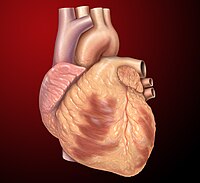
Photo from wikipedia
Background Patients treated at off-hours for acute conditions have increased mortality rates. This effect has been poorly evaluated in patients treated by mechanical thrombectomy (MT). Objective This study aimed at… Click to show full abstract
Background Patients treated at off-hours for acute conditions have increased mortality rates. This effect has been poorly evaluated in patients treated by mechanical thrombectomy (MT). Objective This study aimed at comparing outcomes between patients treated at off-hours and at working hours by MT for acute stroke due to large-vessel occlusion in the anterior circulation, in a well-organised network. Method We included consecutive adults who underwent MT for large-vessel occlusion in the anterior circulation over a 51-month period, in the network of 16 hospitals from the North-of-France area, sharing similar protocols. Patients underwent magnetic resonance imaging-scans at admission and then 22–36 h later. We compared 3-month outcomes of patients treated at off-hours and at working time, the primary outcome being a modified Rankin scale (mRS) 0 to 2. Results The study population consisted of 1,179 patients (631 women, 53.5%; mean age 72 years; median baseline National Institutes of Stroke Scale 17; 639 at off-hours, 54.2%; 734 treated with rt-PA, 62.3%; median delay stroke recognition to end of MT 281 min). No patient was lost to follow-up. The outcomes did not differ between the two groups: adjusted odds ratio ( adj OR) for mRS 0–2: 0.89; 95% confidence interval (CI) 0.67–1.18; adj OR for mRS 0–1: 0.91; 95% CI 0.68–1.21; adj OR for death 1.12; 95% CI 0.81–1.55). Conclusion Our study did not show worse outcomes in patients treated at off-hours. This result suggests that the off-hours effect reported in other studies can be minimized by a coordinated organisation of stroke care providing similar levels of care at off-hours.
Journal Title: Journal of Neurology
Year Published: 2020
Link to full text (if available)
Share on Social Media: Sign Up to like & get
recommendations!